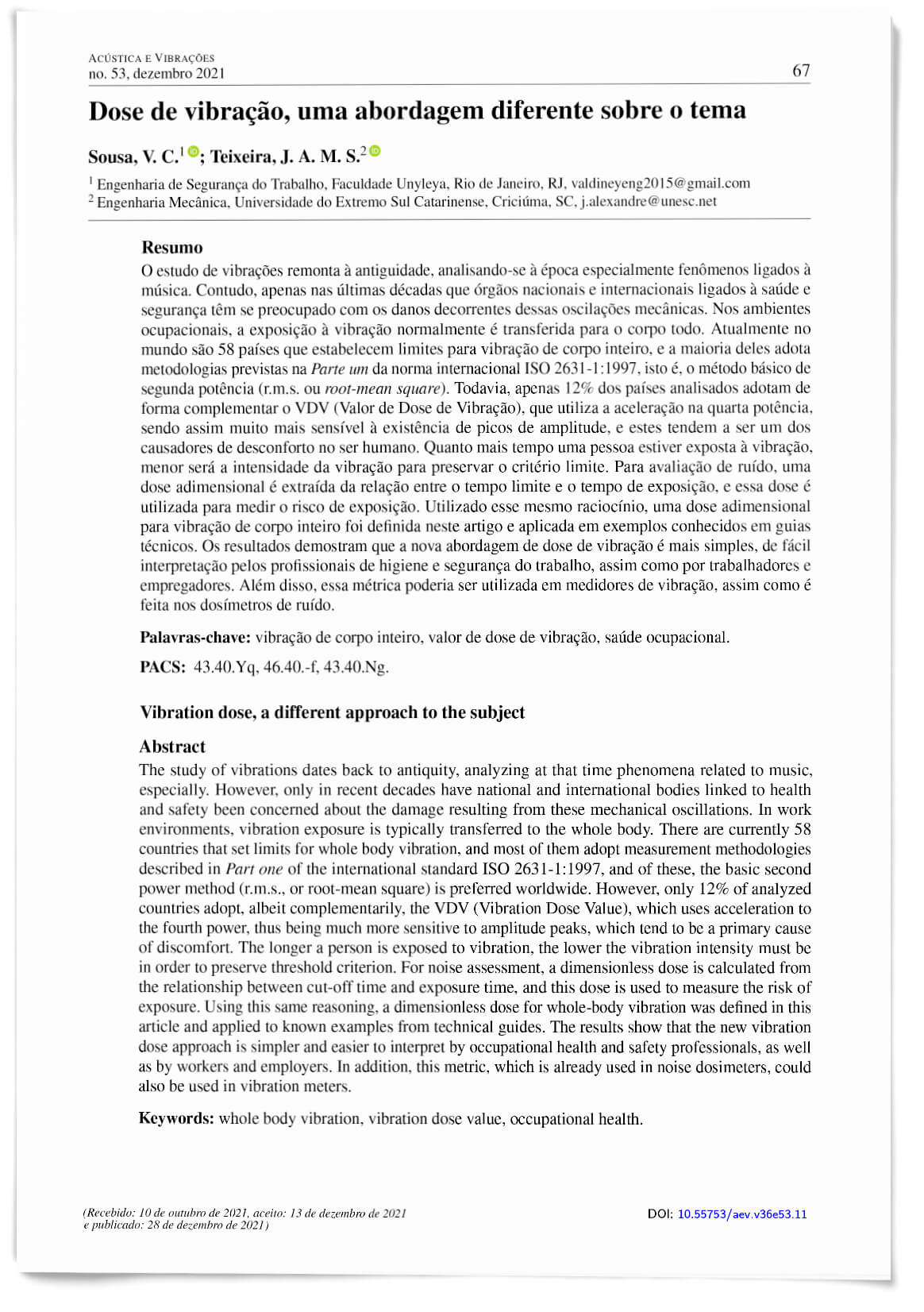Vibration dose, a different approach to the subject
DOI:
https://doi.org/10.55753/aev.v36e53.11Keywords:
whole body vibration, occupational healthAbstract
The study of vibrations dates back to antiquity, analyzing at that time phenomena related to music, especially. However, only in recent decades have national and international bodies linked to health and safety been concerned about the damage resulting from these mechanical oscillations. In work environments, vibration exposure is typically transferred to the whole body. There are currently 58 countries that set limits for whole body vibration, and most of them adopt measurement methodologies described in Part one of the international standard ISO 2631-1:1997, and of these, the basic second power method (r.m.s., or root-mean square) is preferred worldwide. However, only 12% of analyzed countries adopt, albeit complementarily, the VDV (Vibration Dose Value), which uses acceleration to the fourth power, thus being much more sensitive to amplitude peaks, which tend to be a primary cause of discomfort. The longer a person is exposed to vibration, the lower the vibration intensity must be in order to preserve threshold criterion. For noise assessment, a dimensionless dose is calculated from the relationship between cut-off time and exposure time, and this dose is used to measure the risk of exposure. Using this same reasoning, a dimensionless dose for whole-body vibration was defined in this article and applied to known examples from technical guides. The results show that the new vibration dose approach is simpler and easier to interpret by occupational health and safety professionals, as well as by workers and employers. In addition, this metric, which is already used in noise dosimeters, could also be used in vibration meters.
References
MANSFIELD, NEIL J. Human response to vibration. Boca Raton, FL: CRC Press, 2005. OCLC: 62208357. ISBN 9780203487228. Disponível em: http://site.ebrary.com/id/10162776.
GRIFFIN, Michael J. Handbook of human vibration. 1. print. paperback ed. ed. London: Acad. Press, 1996. OCLC: 39151533. ISBN 9780123030405 9780123030412.
NORMALIZAçãO, Comité Europeu de. EN 14253 - Mechanical vibration — Measurement and calculation of occupational exposure to whole-body vibration with reference to health — Practical guidance. [S.l.]: Comité Europeu de Normalização, 2008.
STANDARDIZATION, INTERNATIONAL ORGANIZATION FOR. ISO 2631-1- Evaluation of human exposure to whole-body vibration part 1 general requirements. 1985.
STANDARDIZATION, INTERNATIONAL ORGANIZATION FOR. ISO 2631-1: mechanical vibration and shock: evaluation of human exposure to whole body vibration: Part 1: general requirements. Geneva, 2010. Amendment 1. 1997.
INSTITUTION, British Standards. 6. BS 6841 Guide to Measurement and evaluation of human exposure to whole-body mechanical vibration and repeated shock. [S.l.]: British Standards Institution, 1987.
BURGESS-LIMERICK, Robin. Measuring and Managing Workplace Whole-Body Vibration Exposures. Acoustics Australia, v. 44, n. 1, p. 129–135, abr. 2016. ISSN 0814-6039, 1839-2571. doi: 10.1007/s40857-015-0032-5. Disponível em: http://link.springer.com/10.1007/s40857-015-0032-5. DOI: https://doi.org/10.1007/s40857-015-0032-5
HYGIENISTS, AMERICAN CONFERENCE OF GOVERNMENTAL INDUSTRIAL. TLVs e BEIs. [S.l.]: TLVs e BEIs: baseados na documentação dos limites de exposição ocupacional (TLVs) para substâncias químicas e agentes físicos & índices biológicos de exposição (BEIs)., 2020.
CATION, Sarah; JACK, Robert; OLIVER, Michele; DICKEY, James P.; LEE-SHEE, Natasha K. Six degree of freedom whole-body vibration during forestry skidder operations. International Journal of Industrial Ergonomics, v. 38, n. 9-10, p. 739–757, set. 2008. ISSN 01698141. doi: 10.1016/j.ergon.2007.10.003. Disponível em: https://linkinghub.elsevier.com/retrieve/pii/S0169814107001874. DOI: https://doi.org/10.1016/j.ergon.2007.10.003
GRIFFIN, Michael J.; WHITHAM, Eleri M. Discomfort produced by impulsive whole-body vibration. The Journal of the Acoustical Society of America, v. 68, n. 5, p. 1277–1284, nov. 1980. ISSN 0001-4966. doi: 10.1121/1.385121. Disponível em: http://asa.scitation.org/doi/10.1121/1.385121. DOI: https://doi.org/10.1121/1.385121
GRIFFIN, Michael J.; WHITHAM, Eleri M. Time dependency of whole-body vibration discomfort. The Journal of the Acoustical Society of America, v. 68, n. 5, p. 1522–1523, nov. 1980. ISSN 0001-4966. doi: 10.1121/1.385078. Disponível em: http://asa.scitation.org/doi/10.1121/1.385078. DOI: https://doi.org/10.1121/1.385078
ORCID. Michael Griffin (0000-0003-0743-9502). Disponível em: http://orcid.org/0000-0003-0743-9502.
GRIFFIN, Michael J. VIBRATION DOSE VALUES FOR WHOLE-BODY VIBRATION: SOME EXAMPLES. Institute of Sound and Vibration Research The University Southampton, 1984. Disponível em: https://eprints.soton.ac.uk/430080/1/3080U_MJG_1984.pdf.
STANDARDIZATION, INTERNATIONAL ORGANIZATION FOR. International Standard ISO 30326-1-Mechanical vibration—Laboratory method for evaluating vehicle seat vibration — Part 1: Basic requirements. 1994.
COMMUNITIES, Official Journal of the European. Directive 2002/44/EC of the European Parliament and of the Council of 25 June 2002 on the minimum health and safety requirements regarding the exposure of workers to the risks arising from physical agents (vibration). Official Journal of the European Communities, L177/13. EUROPEAN COMMISSION, 2002. Disponível em: https://eur-lex.europa.eu/legal-content/EN/ALL/?uri=CELEX%3A32002L0044.
GRIFFIN, Michael J. Chapter 50 - Vibration. Disponível em: http://www.ilocis.org/documents/chpt50e.htm.
BONGERS, Paulien; BOSHUIZEN, Hendrike Cornelie. Back disorders and whole-body vibration at work. Alblasserdam: Kanter, 1990. OCLC: 46209272. ISBN 9789090036687.

Downloads
Published
How to Cite
Issue
Section
License
Copyright (c) 2021 Acústica e Vibrações

This work is licensed under a Creative Commons Attribution-NonCommercial-ShareAlike 4.0 International License.




